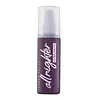What's inside
What's inside
 Key Ingredients
Key Ingredients

 Benefits
Benefits

 Concerns
Concerns

 Ingredients Side-by-side
Ingredients Side-by-side

Water
Skin ConditioningAlcohol Denat.
AntimicrobialKaolin
AbrasivePvp
Emulsion StabilisingDipropylene Glycol
HumectantPhenoxyethanol
PreservativePolyhydroxystearic Acid
EmulsifyingCaprylyl Glycol
EmollientDimethicone PEG-7 Phosphate
CleansingIsononyl Isononanoate
EmollientEthylhexyl Isononanoate
EmollientMethyl Methacrylate Crosspolymer
Sodium Cocamidopropyl Pg-Dimonium Chloride Phosphate
CleansingGlycereth-5 Lactate
EmollientPPG-3 Benzyl Ether Myristate
EmollientPhenylpropanol
MaskingPropanediol
SolventMethyl Diisopropyl Propionamide
MaskingSodium Hydroxide
BufferingAloe Barbadensis Leaf Juice Powder
Skin ConditioningMaltodextrin
AbsorbentPoloxamer 407
EmulsifyingTocopherol
AntioxidantPotassium Sorbate
PreservativeSodium Benzoate
MaskingPentaerythrityl Tetra-Di-T-Butyl Hydroxyhydrocinnamate
AntioxidantParfum
MaskingWater, Alcohol Denat., Kaolin, Pvp, Dipropylene Glycol, Phenoxyethanol, Polyhydroxystearic Acid, Caprylyl Glycol, Dimethicone PEG-7 Phosphate, Isononyl Isononanoate, Ethylhexyl Isononanoate, Methyl Methacrylate Crosspolymer, Sodium Cocamidopropyl Pg-Dimonium Chloride Phosphate, Glycereth-5 Lactate, PPG-3 Benzyl Ether Myristate, Phenylpropanol, Propanediol, Methyl Diisopropyl Propionamide, Sodium Hydroxide, Aloe Barbadensis Leaf Juice Powder, Maltodextrin, Poloxamer 407, Tocopherol, Potassium Sorbate, Sodium Benzoate, Pentaerythrityl Tetra-Di-T-Butyl Hydroxyhydrocinnamate, Parfum
Water
Skin ConditioningHamamelis Virginiana Water
AstringentAlcohol
AntimicrobialPropanediol
SolventVp/Va Copolymer
Glycereth-26
Humectant1,2-Hexanediol
Skin ConditioningMethylpropanediol
SolventPEG-40 Hydrogenated Castor Oil
EmulsifyingSuccinic Acid
BufferingNiacinamide
SmoothingPanthenol
Skin ConditioningCaprylhydroxamic Acid
Disodium EDTA
Parfum
MaskingStephania Tetrandra Root Extract
Skin ConditioningAloe Barbadensis Leaf Extract
EmollientZinc PCA
HumectantResveratrol
AntioxidantBisabolol
MaskingMalachite Extract
AntioxidantWater, Hamamelis Virginiana Water, Alcohol, Propanediol, Vp/Va Copolymer, Glycereth-26, 1,2-Hexanediol, Methylpropanediol, PEG-40 Hydrogenated Castor Oil, Succinic Acid, Niacinamide, Panthenol, Caprylhydroxamic Acid, Disodium EDTA, Parfum, Stephania Tetrandra Root Extract, Aloe Barbadensis Leaf Extract, Zinc PCA, Resveratrol, Bisabolol, Malachite Extract
Ingredients Explained
These ingredients are found in both products.
Ingredients higher up in an ingredient list are typically present in a larger amount.
Parfum is a catch-all term for an ingredient or more that is used to give a scent to products.
Also called "fragrance", this ingredient can be a blend of hundreds of chemicals or plant oils. This means every product with "fragrance" or "parfum" in the ingredients list is a different mixture.
For instance, Habanolide is a proprietary trade name for a specific aroma chemical. When used as a fragrance ingredient in cosmetics, most aroma chemicals fall under the broad labeling category of “FRAGRANCE” or “PARFUM” according to EU and US regulations.
The term 'parfum' or 'fragrance' is not regulated in many countries. In many cases, it is up to the brand to define this term.
For instance, many brands choose to label themselves as "fragrance-free" because they are not using synthetic fragrances. However, their products may still contain ingredients such as essential oils that are considered a fragrance by INCI standards.
One example is Calendula flower extract. Calendula is an essential oil that still imparts a scent or 'fragrance'.
Depending on the blend, the ingredients in the mixture can cause allergies and sensitivities on the skin. Some ingredients that are known EU allergens include linalool and citronellol.
Parfum can also be used to mask or cover an unpleasant scent.
The bottom line is: not all fragrances/parfum/ingredients are created equally. If you are worried about fragrances, we recommend taking a closer look at an ingredient. And of course, we always recommend speaking with a professional.
Learn more about ParfumPropanediol is an all-star ingredient. It softens, hydrates, and smooths the skin.
It’s often used to:
Propanediol is not likely to cause sensitivity and considered safe to use. It is derived from corn or petroleum with a clear color and no scent.
Learn more about PropanediolWater. It's the most common cosmetic ingredient of all. You'll usually see it at the top of ingredient lists, meaning that it makes up the largest part of the product.
So why is it so popular? Water most often acts as a solvent - this means that it helps dissolve other ingredients into the formulation.
You'll also recognize water as that liquid we all need to stay alive. If you see this, drink a glass of water. Stay hydrated!
Learn more about Water